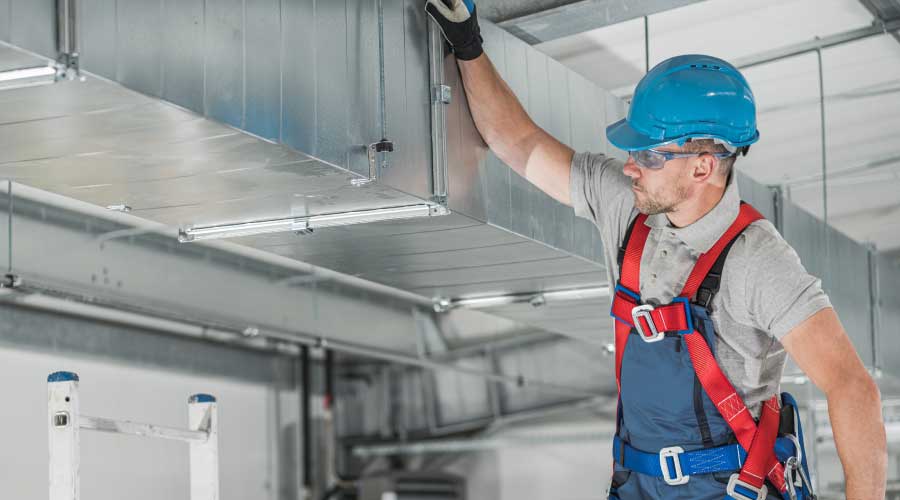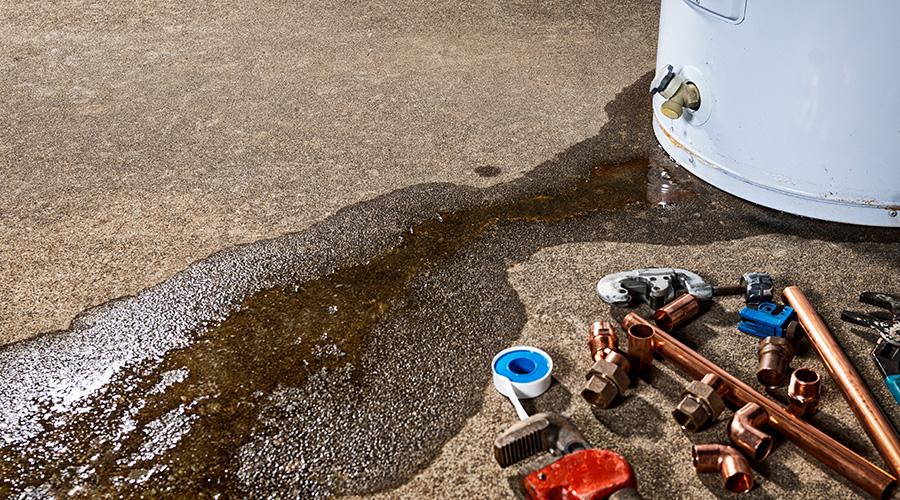Devil in the HVAC Details
Big-ticket equipment gets most of the focus, but attention to support technology, such as water-treatment systems, can generate big savings
When questions about energy efficiency and cost-effective arise in institutional and commercial facilities, the focus often settles on large, big-ticket pieces of equipment. This situation is understandable, given costs and the impact these products can have on facility operations and organizations’ bottom lines.
But as scrutiny grows stronger, engineering and maintenance managers more often look to support systems and equipment and the roles they play in ensuring the efficiency of HVAC systems. From water-treatment systems and pumps to steam traps, a range of often-overlooked support equipment play central roles in smooth, energy-efficient operations.
The support equipment is just as important as the big-ticket equipment, not only because it enhances the quantity and quality of the power supply but because it greatly impacts operating reliability, capacity, cost, and the useful life of the entire system.
Water Treatment
The most effective maintenance program for steam-generating equipment begins with water treatment tailored to facilities’ specific needs. Whether the water supply is from surface, underground or treated city water, managers still will need to develop and implement a daily water treatment program. The type and amount of treatment is determined by daily analysis of the content of the water supply.
All water supplies change constantly, due to the nature of environmental conditions, such as the amount of rainfall and air pollution. While natural sedimentation and filtration through underground water passages take place, these processes do not remove enough of the organic and inorganic chemicals in the form of gases, suspended and dissolved solids to bring the water quality up to boiler specifications.
Most generating plants have a daily water-treatment program set up with recommendations from their water-treatment chemical supplier, who can assist in initial testing and setting up the treatment program.
The critical ingredient in a water-treatment program is daily testing for chemical composition of the makeup and return water at carefully selected points in the system, as well as treatment tailored to test results and the needs of the systems.
Because the variety of available mechanical and chemical treatment is so great, and because water supplies have tended to degrade in recent decades, it is essential to maintain close communications with a water-testing and chemical-supply vendor in order to ensure that the program is keeping pace with ongoing changes in systems and facilities.
In addition to safer, more reliable steam-generating operation, managers might be able to reduce operating costs by taking advantage of new technology.
Feedwater Pumps
Feedwater to make steam comes from two sources: city water or well water — called makeup water — that is pumped to the boiler after treatment or returned condensate. The most economical of the two is returned condensate from the turbine or process steam piping. This feedwater already has been chemically treated to remove solids, hardness and acidity and retains heat.
All of the value added is lost if the condensate is imply drained to the sewer. All of the water supplied to the boiler travels through the feedwater system, making it critical to operations.
Feedwater pumps are electric motor or steam driven, and like all pumps, they need periodic preventive maintenance to operate efficiently. One major consideration is that the temperature is higher in feedwater systems because the returned condensate portion of the water might be at 180 degrees. Makeup water — water added to make up for losses such as seal leakage or condensate that is not piped back to the boiler — also is heated to avoid cold-water shock in the boiler.
To handle this high-temperature fluid, packing cannot be the soft, braided type used in cold-water service. Instead, it must be made of soft metal, such as copper alloy, in rings that can be formed tightly around the shaft in the stuffing box to seal the gap between the shaft and the casing without scoring the shaft.
Another type is the mechanical seal, a carbon ring and spring arrangement. A very thin, steady water leakage at the packing gland indicates the packing is tightened properly. No leaks means the packing is too tight. A heavy stream means it is too loose.
The pump’s water leakage must be kept from flashing into steam in the low-pressure stuffing box area to prevent scoring from abrasive minerals in the water. Feedwater pumps are supplied with cooling water piping and water jackets around the stuffing box to control temperature. It is a good practice to monitor the cooling-water temperature, keeping sufficient flow to hold it at no higher than 160 degrees.
If the temperature begins to rise, technicians should look for low water flow, plugged lines, or worn or too-tight packing that can cause high-friction heat. Tech-nicians can correct these conditions using one of two methods:
- If the problem is low cooling-water flow, and the pressure in the line is normal, technicians can open the valve to increase flow. If this does not work, the line probably is plugged up with deposits and should be replaced.
- If the cooling-water flow is normal, then the problem is worn or too-tight packing. If backing off and retightening the packing gland nuts does not correct the problem, technicians can remove the packing and check the stuffing box for wear. If the stuffing box and shaft sleeve are in good condition, technicians can replace the packing. If they are worn, they should shut down the pump and replace the worn parts. It is a good practice to check the impeller, casing wear rings, and other rotating parts — including bearings — at this time so they can be replaced, if needed during the shut-down.
Piping
Piping is designed for the pressure and service required for each application. For drain lines, vent lines and other pressure service, managers should specify schedule 40 pipe at 150 pounds per square inch (psi) working pressure. For a high-pressure steam line such as 175 psi, managers should specify extra-heavy schedule 80 pipe at 300 psi working pressure.
If piping lasts a long time but fails without warning, a good predictive technique is to insert a test specimen in the pipeline at the trouble spot. Periodic measurement of mils — thousandths of an inch — of metal lost in the specimen will indicate the optimum time to replace the pipe.
Steam Traps
Common types of traps include bimetallic, bucket, thermodynamic and thermostatic, or bellows. They all work on the principle that condensate and steam have different physical properties, which form the basis for separating the two.
Bimetallic traps operate on the temperature differential acting on a bimetallic element. Greater temperature difference indicates more condensate, which opens the trap more, allowing greater condensate to discharge.
The bucket trap is made of an inverted bucket with a vent hole on the top. The bucket is connected to a lever arm. When the condensate fills the trap body, air and steam escape. The lever arm holds the valve closed. As the bucket sinks, the valve opens, discharging condensate. The cycle repeats with a frequency dependent on the volume of condensate forming in the line.
Thermodynamic traps operate on the difference in kinetic energy of condensate and steam. As condensate builds up on the face of the trap disk, the disk separates from the seat, allowing the condensate to pass through the valve. When the condensate is discharged, the steam closes the disk on the seat again.
The thermostatic steam trap employs a bellows. A bellows-and-steam-trap assembly reacts to the presence of condensate, opening the valve so condensate can discharge. As steam again contacts the bellows, the valve stem forces the valve closed.
One of the most common indicators that a steam trap is not working or is installed in the wrong location is water hammer — condensate buildup colliding at high speed at a bend in the pipeline or some other obstruction. Another indication is steady discharge of steam and water vapor at the stem-trap vent line.
When these conditions occur, it is time for technicians to inspect the internal mechanism and replace it if it is worn or corroded from service. This is also a good time to check its size and to make sure that it is correct for the service conditions.
If the trap is working, technicians will be able to feel a difference in the temperature of the steam line — higher — and the condensate line — lower. Or more accurately, they will be able to measure the temperature by placing a pyrometer probe on a clean metal spot on the pipe line on both sides of the trap. On cycling traps, technicians can listen for the action of the trap with a stethoscope.
Some traps, such as the bucket type, have a tell-tale indicator that rises and falls with the trap action. Bellows and disk traps are available that make an audible sound that can be picked up by the unaided ear when they cycle.
Closer attention to these and other HVAC support systems can enhance system reliability and hold down energy costs.
Water Impurities and Treatments
|
| IMPURITY |
TREATMENT/EFFECT
|
EQUIPMENT
|
|
| Suspended solids |
- Coagulation, flocculation to increase particle size and settling speed. Also removes some calcium and magnesium hardness
|
|
|
|
|
|
|
- Pre-coat cartridge filter
|
|
| Hardness/Dissolved solids |
- Precipitation with lime, soda ash and caustic
|
|
- Ion exchange. Cations exchange resins in series, produce demineralized water.
|
|
|
| Dissolved bases |
Diffuse air bubbles through water to remove CO2 and H2O
|
|
|
| Dissolved oxygen |
|
|
| |
- Chemical removal with sulfites and hydrazine
|
|
|
| Acidic corrosion |
Chemical treatment with sodium hydroxide to keep pH between 9 and 10.5
|
|
|
Carbonic acid
|
Filming amines coat steam and condensate piping with molecular film to prevent corrosion
|
Positive-displacement pump
|
|
— Thomas Westerkamp
Related Topics:











